

Les Techniques - Les coutures - La double-bride - Les augmentations - La bride - La maille serrée - Mon Crochet. Abréviation :Db Sur une chaînette de base, faites 2 jetés, puis piquez le crochet dans la cinquième maille à partir du crochet.

Ramenez une boucle à travers la maille chaînette. Le crochet porte quatre boucles. Faites un jeté et coulez deux boucles. Il reste trois boucles sur le crochet. Il reste deux boucles sur le crochet. Pour faire un rang de doubles brides, répétez les étapes précédentes en piquant dans chaque maille du rang. Astuce: Les brides triples (ou quadruples) se font de la même façon. Publié dans : Les Techniques - Par FiFlo 1. Tricoter des modèles en anglais, pas à pas (2/2) Maintenant que vous avez « fait connaissance » avec votre modèle et que vous êtes préparés à tricoter « directement » en anglais, attaquons donc le corps de notre modèle (« directions » en anglais).
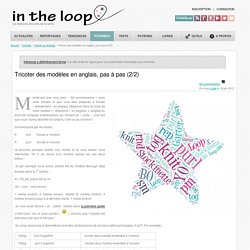
L’anglais du tricot est composé d’abréviations qui forment un « code ». Une fois que vous l’aurez déchiffré et compris, c’est un jeu d’enfant ! Commençons par les bases : K knit tricoter à l’endroit P purl tricoter à l’envers Je pourrais presque arrêter mon article ici et vous laisser vous débrouiller, 50 % au moins d’un modèle repose sur ces deux lettres ! Si par exemple nous avons (extrait tiré du modèle Borough déjà évoqué dans la 1e partie) : K1, P4, [k2, p4] to last st, k1. En « clair » cela donne : 1 maille endroit, 4 mailles envers, répéter [2 mailles endroit, 4 mailles envers] jusqu’à la dernière maille, 1 maille endroit. Techniques, trucs et astuces.
Substituting yarn, a few thoughts. Rae mentioned in the comments that yarn substitution is hard for her.
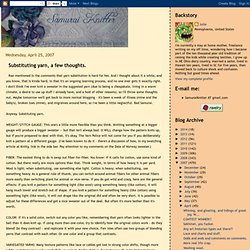
And I thought about it a while, and you know, that is kinda hard, in that it's an ongoing learning process, and no one ever gets it exactly right. I don't think I've ever knit a sweater in the suggested yarn (due to being a cheapskate, living in a warm climate, a desire to use up stuff I already have, and a host of other reasons), so I'll throw some thoughts out. Maybe tomorrow we'll get back to more normal blogging - it's been a week of illness (mine and the baby's), broken toes (mine), and migraines around here, so I've been a little neglectful.
Bad Samurai. Anyway. WEIGHT/STITCH GAUGE: This one's a little more flexible than you think. FIBER: The easiest thing to do is swap out fiber-for-fiber. COLOR: If it's a solid color, switch out any color you like, remembering that yarn often looks lighter in the ball than it does knit up. Wool: light, warm, breatheable. Lexique.pdf. How to Read Amigurumi Patterns. I have been receiving some e-mails recently from people asking how to read amigurumi patterns.
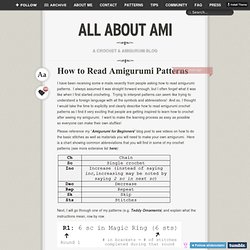
I always assumed it was straight forward enough, but I often forget what it was like when I first started crocheting. Trying to interpret patterns can seem like trying to understand a foreign language with all the symbols and abbreviations! And so, I thought I would take the time to explicitly and clearly describe how to read amigurumi crochet patterns as I find it very exciting that people are getting inspired to learn how to crochet after seeing my amigurumi. I want to make the learning process as easy as possible so everyone can make their own stuffies! Please reference my “Amigurumi for Beginners" blog post to see videos on how to do the basic stitches as well as materials you will need to make your own amigurumi.
Next, I will go through one of my patterns (e.g. Translation: Work six single crochets in a magic ring. Translation: Work two single crochets in each single crochet around. Amigurumi for Beginners. Ever since I started my blog, it’s been great connecting with people from a wide variety of backgrounds in crochet.
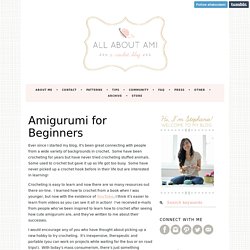
Some have been crocheting for years but have never tried crocheting stuffed animals. Some used to crochet but gave it up as life got too busy. Some have never picked up a crochet hook before in their life but are interested in learning! Crocheting is easy to learn and now there are so many resources out there on-line. I learned how to crochet from a book when I was younger, but now with the existence of YouTube, I think it’s easier to learn from videos as you can see it all in action! I would encourage any of you who have thought about picking up a new hobby to try crocheting.
Here are some resources that I find helpful and that I recommend to people who want to learn how to make amigurumi but don’t know where to begin. Almost all parts of an amigurumi (e.g. head, arms, legs, body) are formed by crocheting around a circle. 1. 2. Le crochet. 1.
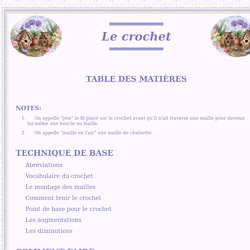
On appelle "jeté" le fil placé sur le crochet avant qu'il n'ait traversé une maille pour devenir lui-même une boucle ou maille. 2. On appelle "maille en l'air" une maille de chaînette. AbréviationsVocabulaire du crochetLe montage des maillesComment tenir le crochetPoint de base pour le crochetLes augmentations Les diminutions.